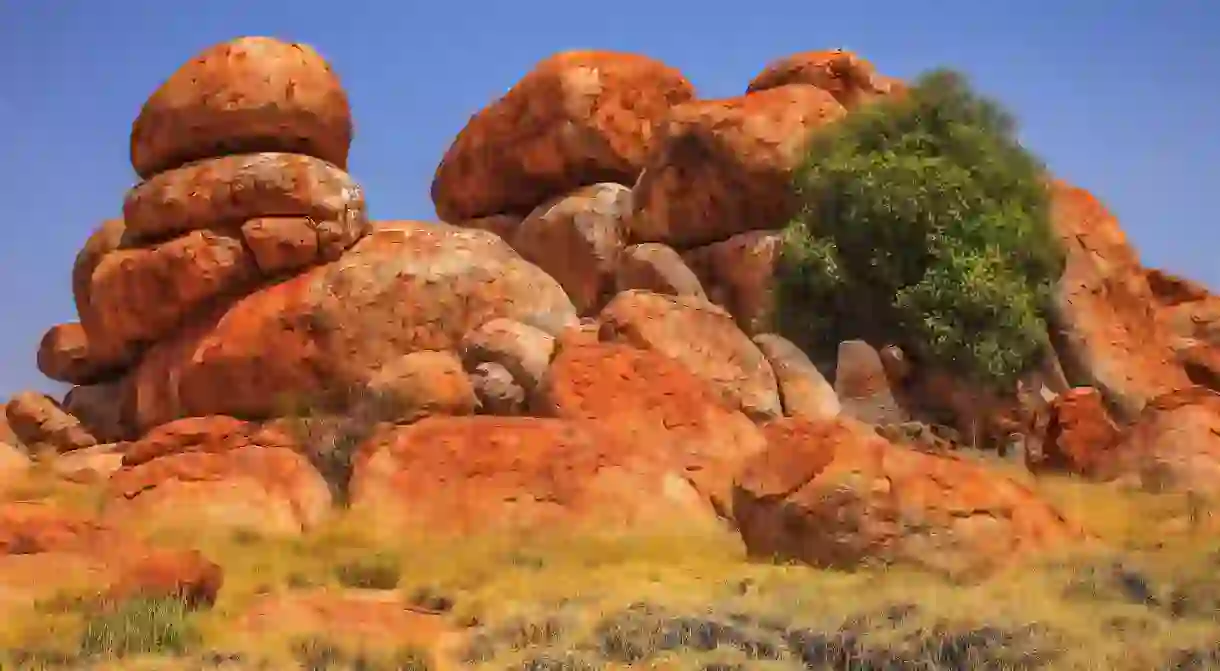The 10 Most Beautiful Natural Sights in Australia's Northern Territory

From top to bottom and east to west, the Northern Territory is full of natural wonders. This includes scenic waterfalls, World Heritage-listed national parks and sacred Aboriginal sites. Here are the most beautiful natural sights you need to witness for yourself in the Northern Territory.
Uluru
Natural Feature, Park

Kings Canyon
Natural Feature, Park

Waterfalls and wetlands at Kakadu National Park
Natural Feature, Park

It’s difficult to pick just one breathtaking natural sight in Kakadu National Park, as it’s home to waterfalls, wetlands and stunning swimming holes. Jim Jim Falls is accessible via an unsealed road. A 900-metre (0.6-mile) descent will have you swimming in its deep plunge pools, which include a sandy beach. Then there’s Yellow Water billabong, which is considered to be one of the best places to see Australian animals in their natural habitat, including saltwater crocodiles, sea eagles and grazing buffalo.
The waterfalls of Litchfield National Park
Natural Feature, Park

West MacDonnell National Park
Natural Feature

How do you pick just one natural sight to see within West MacDonnell National Park too? Located west of Alice Springs, it’s known for many things, including its breathtaking swimming holes like Ormiston Gorge and Ellery Creek Big Hole. Simpsons Gap is another must see, with its towering cliffs, permanent waterhole and native wildlife. Then there’s the ochre pits, which the local Aboriginal people have mined for generations, to use in paintings and for ceremonial body decorations.
Katherine Gorge
Natural Feature, Park

Katherine Gorge is located within Nitmiluk National Park, which is on the traditional lands of the Jawoyn people. The renowned natural feature consists of 13 gorges carved from ancient sandstone, which can be explored by boat, canoe or helicopter. A sunrise or sunset cruise is recommended to see the gorge cliffs change colour. Nitmiluk National Park is also home to Aboriginal rock art sites, hiking trails and several swimming holes.
Cutta Cutta Caves
Natural Feature
Formed millions of years ago, the Cutta Cutta Caves are Australia’s only tropical limestone cave system. Head on a guided tour with Nitmiluk Tours, which will take you 15 metres below the surface, where you can spot stalactites, stalagmites and different bat species. The Cutta Cutta Caves Nature Park includes 1,499 hectares of karst limestone landscape. While visiting the caves, check out the Tropical Woodland Walk to learn more about the native flora and fauna.
Devils Marbles
Natural Feature

The Devils Marbles are located in Karlu Karlu/Devils Marbles Conservation Reserve. This name reflects the reserve’s joint management, between Parks and Wildlife Service of the Northern Territory rangers and the traditional Aboriginal land owners. The large granite boulders, which are a sight to behold, range in size from 50 centimetres to six metres across. Some are split evenly in half, while others balance precariously on top of one another. Their rounded shape is due to years of weathering and erosion.
Kata Tjuta
Natural Feature

Located in Uluru-Kata Tjuta National Park, Kata Tjuta (also known as the Olgas) is often overlooked due to its famous neighbour. However, the iconic red rock domes of Kata Tjuta are only located 40 kilometres (25 miles) from Uluru. Said to be over 500-million-years-old, the natural sight is just as spiritually significant as Uluru to the local Anangu people. See Kata Tjuta from various angles via the Walpa Gorge and Valley of the Winds Walks. The best place for photographs though is the Kata Tjuta dune viewing area.
Palm Valley
Natural Feature, Park

Palm Valley, within Finke Gorge National Park, is a desert oasis that’s home to a variety of plant species, including many unique to the region. It’s also the only place in Central Australia where red cabbage palms survive. It’s said that these plants are botanic remnants from a time millions of years ago, when Central Australia was a tropical forest haven. Despite Palm Valley only receiving an average of 200 millimetres of rainfall annually, there are small semi-permanent spring-fed pools, which help the plant species thrive.













